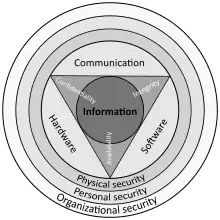Security bug
A security bug or security defect is a software bug that can be exploited to gain unauthorized access or privileges on a computer system. Security bugs introduce security vulnerabilities by compromising one or more of:
- Authentication of users and other entities[1]
- Authorization of access rights and privileges[1]
- Data confidentiality
- Data integrity
Security bugs do not need be identified nor exploited to be qualified as such and are assumed to be much more common than known vulnerabilities in almost any system.
Causes
Security bugs, like all other software bugs, stem from root causes that can generally be traced to either absent or inadequate:[2]
- Software developer training
- Use case analysis
- Software engineering methodology
- Quality assurance testing
- and other best practices
Taxonomy
Security bugs generally fall into a fairly small number of broad categories that include:[3]
- Memory safety (e.g. buffer overflow and dangling pointer bugs)
- Race condition
- Secure input and output handling
- Faulty use of an API
- Improper use case handling
- Improper exception handling
- Resource leaks, often but not always due to improper exception handling
- Preprocessing input strings before they are checked for being acceptable
Mitigation
See also
References
- "CWE/SANS TOP 25 Most Dangerous Software Errors". SANS. Retrieved 13 July 2012.
- "Software Quality and Software Security". 2008-11-02. Retrieved 2017-04-28.
- Alhazmi, Omar H.; Woo, Sung-Whan; Malaiya, Yashwant K. (Jan 2006). "Security vulnerability categories in major software systems". Proceedings of the Third IASTED International Conference on Communication, Network, and Information Security.
Further reading
- Open Web Application Security Project (21 August 2015). "2013 Top 10 List".
- "CWE/SANS TOP 25 Most Dangerous Software Errors". SANS. Retrieved 13 July 2012.
This article is issued from Wikipedia. The text is licensed under Creative Commons - Attribution - Sharealike. Additional terms may apply for the media files.
